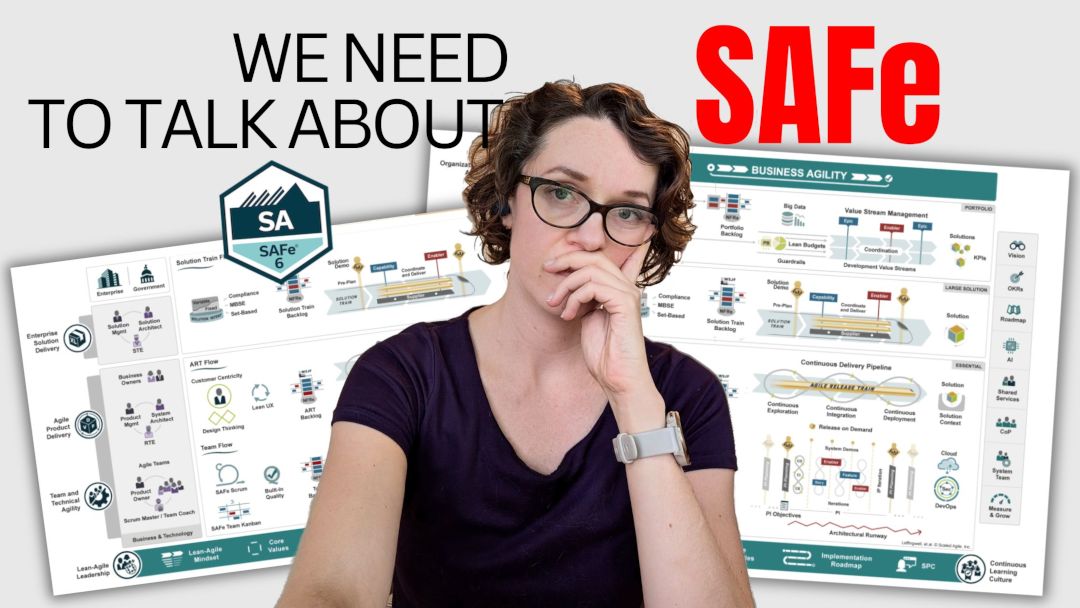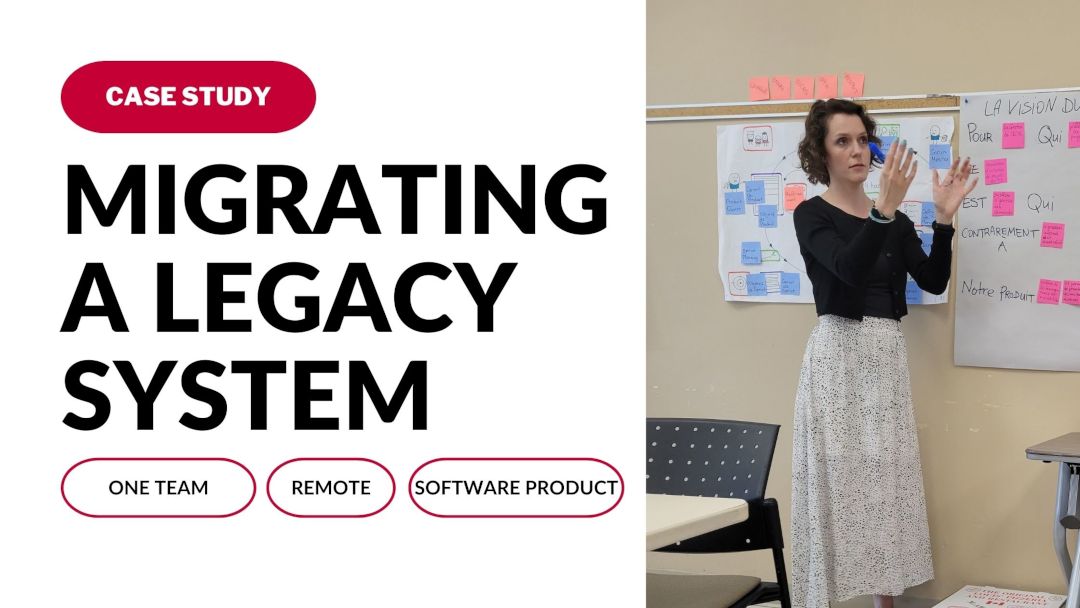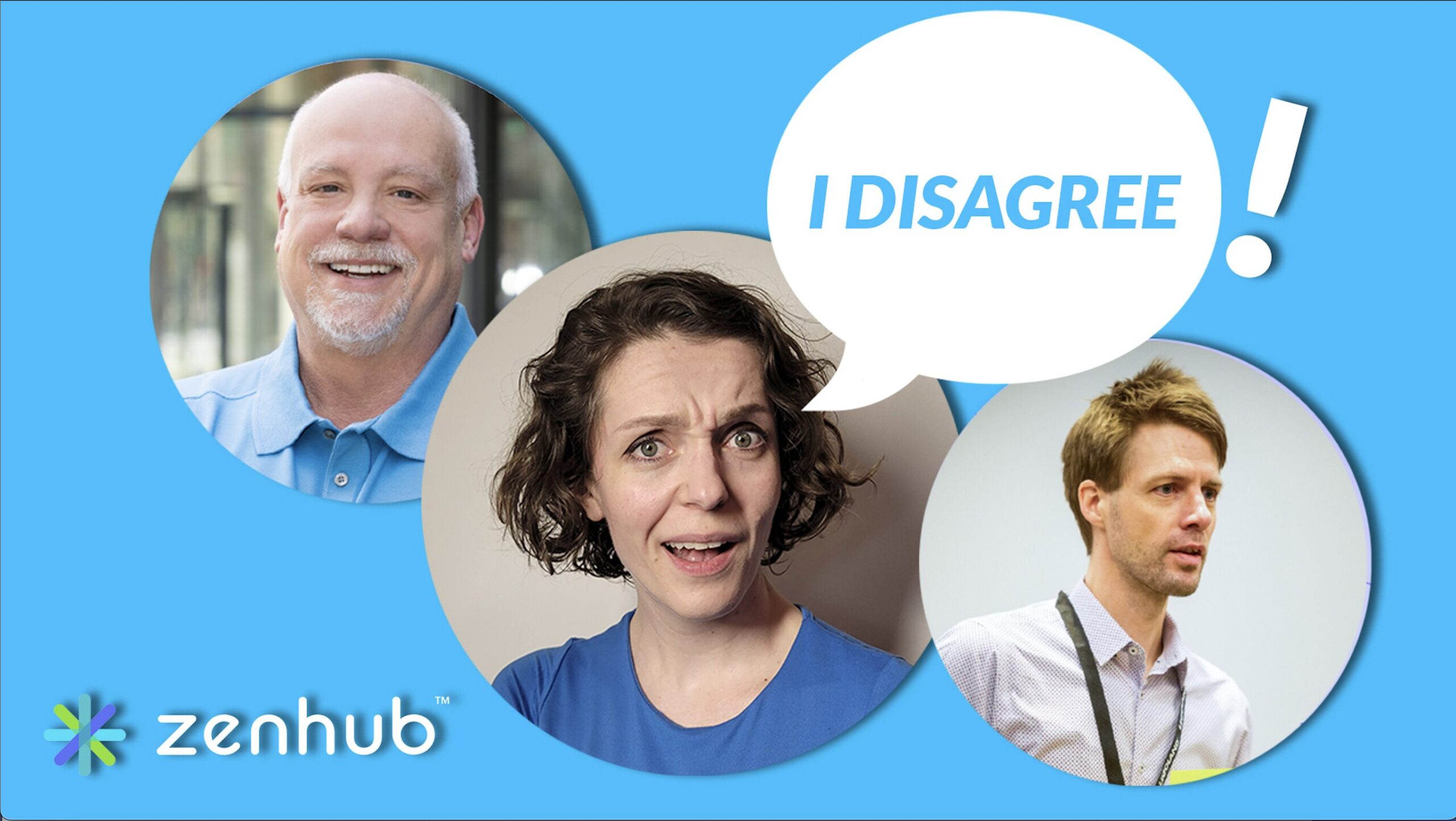Imagine.
You are in a meeting with your team.
The discussion is going ok-ish, but you feel the tension rising.
Then you start to only hear two people talking back-and-forth to each other in frustration.
The rest of the team is silent.
There is a big disagreement in the room that is slowly creeping into the uncomfortable conflict space.
What do you do?
As we all know, there is no team without conflict.
Sometimes the conflict is out there in the open and everyone knows about it, and sometimes it appears like an elephant in the room that no one wants to acknowledge.
In some rare case, the conflict is brewing in secret only to explode in your face in the most unexpected moment.
Whatever the situation is, if you want your team to be successful and become high-performing at some point, you need to be able to address team conflict effectively.
Whether you are a Scrum Master, Team Lead, or just a team member – conflict resolution skills are some of the core skills you have to have.
So let me give you some practical tips on how to deal with conflict in a workplace.
Watch the video or keep reading to learn more!
Ok, let’s talk about conflict.
I know you want me to give you some magic solutions on how to address it, and very likely, how to avoid it.
But let me first talk about why conflict if your best friend and why you should actually encourage it.
Every great team has a conflict
Yep, team conflict is inevitable. But it’s actually good.
I would say that the worst thing you can do for the development of your team is to avoid all conflict or to pretend it’s not there.
When we bring a group of individuals together, we want not only to see the benefits of teamwork, but also to expand the knowledge with different opinions and approaches.
One person working on their own, no matter how smart they are, will be focusing on a limiting number of beliefs and ideas.
While when a team comes together they are able to review a multitude of different ideas and come up with the most optimal solutions based on their combined knowledge.
The solution that a single person might never find due to the limitations they face.
This means, that we want the team to be able to discuss their different opinions and ideas and that will likely lead to disagreements and conflict.
To clarify – I am not talking about mean spirited conflict here.
Any great team will have healthy, productive conflict – a passionate and unfiltered debate around issues.
It’s not about the people, who is right, their personal traits, and what not.
It’s about the best solutions to the problems the team is facing.
Without conflict, there is no team
Ok, let’s say we have a team, and they don’t have any conflict whatsoever. Everybody agrees with everybody.
I would say – that’s suspicious!
Often this means that there is actually conflict, it’s just hidden.
What I mean by that is that people most likely disagree with their team mates on some topics, but they don’t say anything.
There might be a number of reasons why, like:
- They don’t want to hurt their team mates feelings.
- They don’t feel safe to speak up because they think it might be used against them.
- They are afraid of conflict or they have a tendency avoiding it in general.
While it might seem like a good thing, especially for the person not speaking up, this actually leads only to negative outcomes such as resentment towards others and unwillingness to commit to ideas that they disagree with.
This also doesn’t mean that the conflict isn’t there – it just means that it’s not seen and hence, cannot be addressed.
There is a very good reason for why you want to know there is conflict as soon as possible:
Conflict comes in stages
There is a great model developed by Speed Leas for assessing the level of conflict in a situation.
It states that if a conflict is not addressed, it will tend to get worse and that if it does get worse, it will progress through several levels eventually getting to a point where it’s impossible to resolve.
Level One. The conflict starts as a problem to solve, something that highlights that team members have conflicting goals, values, or needs.
If the team members do not address the conflict and come to a solution at this stage, the conflict will escalate to the Level Two where disagreements start surfacing.
At this point the discussion becomes more personal and the problem gets more difficult to define. So the team starts to build some distrust and personalizing the problem.
Without resolution, the conflict escalates to the Level Three where the two sides enter a contest.
It’s no longer about the problem, but about who is right, who will win and who will lose. Other team members start to choose sides. Everyone forgets what the problem was actually about and personal attacks surface.
If this is not resolved, it escalates to Level Four where it’s about Fight/Flight.
The conflict shifts from winning to getting rid of people we disagree with. At this point people have identified who they are siding with. The problem is forgotten and the discussion becomes more ideological.
And at some point, the team will arrive at Level Five: the Intractable Situations, where the personalities have become the focus of the conflict. At this point it’s almost impossible to resolve the situation – it’s too late. The team’s energy is centered on the elimination or destruction of the other side.
It’s easiest to understand any model by applying it to a real-life situation. So imagine this:
- A team lead is reviewing a developer’s code and upon completion says that it needs to be changed because it’s not good enough. The developer disagrees.
Think of how this situation may escalate if they don’t come to an agreement at some point.
Like the developer starts thinking that the team lead is being unreasonable and disrespectful, and the team lead starts thinking that the developer is just stupid. And then it continues….
Addressing conflict
Ok, so now we have a good understanding of all things conflict. What do we do with it?
Very good question.
As always, there is no magic wand to fix it all, but I’ll give you some practical tips you can implement.
Let’s get started.
1 – Help people get comfortable with conflict
As I mentioned before, having healthy conflict in a team is a necessity.
It means you want to make sure that your team knows it and is not afraid of it.
You can run a workshop on this topic or use coaching moments in meetings.
Say it as is: “As a team we will have some disagreements in opinions. And that is absolutely fine. This is how we’ll be able to find the best solutions. So when you disagree, be sure to voice it, and we’ll work together to resolve it. The most important is to keep this conflict healthy and productive. And I’m here to help.”
2 – Set some rules around conflict
Yes, you want to have conflict, but your team needs to know how to deal with it, at least in simple terms.
The easiest way to get started with this is to set some team agreements around conflicting situations.
Ask questions like “What do we do when there is a disagreement?”, “What happens when a conflict can’t be resolved?”, “Who has the final word?”.
If you need help with setting team agreements, I have a guide you can use to run an engaging and productive workshop with your team.
Team Agreements Workshop
Help your team agree on how they want to work together and get to the performing stage faster with this workshop Team Agreements. A step-by-step facilitation guide and Miro templates for virtual delivery.
![How to resolve team conflict in the workplace [with EXAMPLES] 1 - ScrumMastered STORE BANNERS 10 3 - ScrumMastered 2024](https://scrummastered.com/wp-content/uploads/2024/04/STORE-BANNERS-10-3.png)
3 – Recognize when there is conflict
One more level in the Speed Leas model is Level Zero – Depression, or “anger turned inward”.
Sometimes team members don’t know they are in conflict because they are in a state of depression.
You want to avoid this situation, and that’s where the next important step in resolving conflict comes in.
Your goal is to raise team members’ awareness that there are problems to be solved. You want to make it extremely clear and transparent.
And we talked a lot about transparency already, so this is a good example of where it becomes essential once again.
You can use the Sprint Retrospective to highlight it, or if you see it happening in the moment – address it right then and there.
4 – Identify the problem to solve
Looking back at the Speed Leas model, we can see how quickly the attention can turn from the problem itself to the people involved and become personal.
To avoid this escalation, you want to clarify the problem at hand and even document it for future reference.
- What is the disagreement actually about?
- What are the options, opinions, ideas suggested? Don’t focus on who those ideas are coming from – that’s irrelevant.
- What are the pros and cons of each option? Ask for a rational and unbiased look. Maybe even ask the opposing side to describe the pros of the competing approach.
Whenever you feel the conversation is moving away from the problem, bring it back – “We are here to talk about this specific issue. So let’s stay focused”.
5 – Teach your team to use tools and models to address conflict
You can’t just throw someone who doesn’t know how to swim in the water and hope they learn to swim on their own. Especially, if you are a Scrum Master.
Apart from having team agreements answer some questions about disagreements, you need to bring in some practical ways to address conflict.
There are some tools and models that can be quite helpful.
While they might not be a magic wand to solving all the disagreements, they can help keep conflicts from escalating.
Firstly, I would recommend looking into the Nonviolent Communication by Marshall B. Rosenberg.
It is a method designed to increase empathy and improve communication.
It encourages the change in the language we use in conflict situations from judgment, interpretations, and criticisms to expressing feelings and needs.
I’ll link the book and a video below for you to learn more about it.
Another great tool is the Empathy Map.
I mentioned it a couple of times in my older articles.
Basically, the Empathy Map is an exercise you can run with the people involved in conflict to help them understand the other party better and create empathy in how they communicate with each other.
As you can see, empathy plays an important role in addressing conflict.
And of course, if there is an environment of trust in your team, then you will have a better chance of resolving some conflicting situations quickly.
Here is a video about building trust in teams:
Now, back to you: what are some of the tools and practices you use to help address team conflict in the workplace?
![How to resolve team conflict in the workplace [with EXAMPLES] 2 - ScrumMastered nonviolent communication - ScrumMastered 2024](https://scrummastered.com/wp-content/uploads/2023/05/nonviolent-communication-753x1024.jpg)
![How to resolve team conflict in the workplace [with EXAMPLES] 3 - ScrumMastered nonviolent communication by marshal - ScrumMastered 2024](https://scrummastered.com/wp-content/uploads/2023/05/nonviolent-communication-by-marshal-1024x559.jpg)
![How to resolve team conflict in the workplace [with EXAMPLES] 4 - ScrumMastered trust in team - ScrumMastered 2024](https://scrummastered.com/wp-content/uploads/2023/05/trust-in-team-1024x576.jpg)



